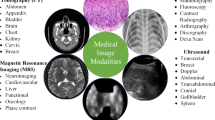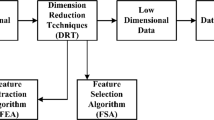Abstract
A paradigm shift is observed in medical domain when it comes to automated identification of several human ailments. Many a research activities are still being carried out in this context towards accuracy and robustness. Brain related disease identification has always been a challenge in this direction. Although handful of benchmark schemes exist related to brain ailment (mainly seizure) identification, however, the specific case of seizure identification for pregnant women has been little explored. In this paper, such a scheme has been proposed that identifies seizure based on the magnetic resonance (MR) digital images especially of pregnant women. The proposed scheme first transforms the MR image through efficient two dimensional discrete orthonormal Stockwell transform (2D-DOST) to obtain meaningful vectors. Further, for generating the final feature vector, the regularized discriminant analysis (RDA) is used. This is followed by the task of identification through classification. There are two classes in this case namely, seizure and no-seizure. This identification is achieved through the utilization of random vector functional link network (RVFL). Along with the typical kernel extension it is dubbed KRVFL. Suitable experimental analysis is conducted that reveals satisfactory results in support of the proposed work with an overall rate of accuracy being 94.5%, 93%, and 92% for the specific samples (seizure during pregnancy), and two other sample sets respectively. The performance measure is done through a k-fold cross validation calculation. Performance comparison with other competent schemes shows that the proposed scheme is marginally efficient.



Similar content being viewed by others
Data availability
The data materials are derived from suitably available datasets and proper citations are made thereby.
Code availability
Packages from Python library have been used for the purpose.
References
Shoeibi A, Khodatars M, Ghassemi N, Jafari M, Moridian P, Alizadehsani R, Panahiazar M, Khozeimeh F, Zare A, Hosseini-Nejad H, Khosravi A, Atiya A, Aminshahidi D, Hussain S, Rouhani M, Nahavandi S, Acharya UR. Epileptic seizures detection using deep learning techniques: A review. Int J Environ Res Public Health. 2021;18:5780, 05.
Ghassemi N, Shoeibi A, Rouhani M, Hosseini-Nejad H. Epileptic seizures detection in eeg signals using tqwt and ensemble learning. 2019;10.
Bhattacharyya A, Pachori R, Upadhyay A, Acharya UR. Tunable-q wavelet transform based multiscale entropy measure for automated classification of epileptic eeg signals. Appl Sci. 2017;7:04.
Gatta G, Di Grezia G, Cuccurullo V, et al. MRI in Pregnancy and Precision Medicine: A Review from Literature. J Pers Med. 2021;12(1):9. Published 2021 Dec 23. https://doi.org/10.3390/jpm12010009.
Perez Sanchez AV, Pérez-Ramírez C, Valtierra-Rodriguez M, Dominguez Gonzalez A, Amezquita-Sanchez J. Wavelet transform-statistical time features-based methodology for epileptic seizure prediction using electrocardiogram signals. Mathematics. 2020; vol. 8, p. 2125, 11.
Silaparasetty N. Machine Learning With Python. 2020;09:67–87.
Nti IK, Aning J, Ayawli B, Kyeremeh F, Appiah A, Nyarko-Boateng O. A comparative empirical analysis of 21 machine learning algorithms for real-world applications in diverse domains. 2021;05.
Del Gaizo J, Mofrad N. Using machine learning to classify temporal lobe epilepsy based on diffusion mri. Brain Behav. 2017;vol. 07, p. e00801, 08.
Perera-Ortega A, Sedghi A, Isen J, Vos SB, Mousavi P, Winston GP. Machine learning to detect brain lesions in focal epilepsy. In Medical Imaging 2021: Image-Guided Procedures, Robotic Interventions, and Modeling, Linte CA and Siewerdsen JH, Eds., vol. 11598, International Society for Optics and Photonics. SPIE; 2021. pp. 297–302.
Alickovic E, Kevric J, Subasi A. Performance evaluation of empirical mode decomposition, discrete wavelet transform, and wavelet packed decomposition for automated epileptic seizure detection and prediction. Biomed Signal Processing and Control. 2018;vol. 39, pp. 94–102, 01.
Sharma M, Shah S, PV A. A novel approach for epilepsy detection using time-frequency localized bi-orthogonal wavelet filter. Journal of Mechanics in Medicine and Biology. 2019;vol. 19, 02.
Parsaei H, Movahedi M, Zamani A, Tavakoli Golpaygani A, Reza M, Poya H. Automated analysis of ultrasound videos for detection of breast lesions. Middle East Journal of Cancer. 2020;vol. 11, pp. 80–90, 01.
Bou Assi E, Nguyen D, Rihana S, Sawan M. Refractory epilepsy: Localization, detection, and prediction. 2018;01.
Shoeibi A, Sadeghi D, Moridian P, Ghassemi N, Heras J, Alizadehsani R, Khadem A, Kong Y, Nahavandi S, Gorriz J. Automatic diagnosis of schizophrenia using eeg signals and cnn-lstm models. 2021; 09.
Sadeghi D, Shoeibi A, Ghassemi N, Moridian P, Khadem A, Alizadehsani R, Teshnehlab M, Gorriz J, Nahavandi S. An overview on artificial intelligence techniques for diagnosis of schizophrenia based on magnetic resonance imaging modalities: Methods, challenges, and future works. 2021;02.
Craik A, He Y, Contreras-Vidal J. Deep learning for electroencephalogram (eeg) classification tasks: A review. J Neural Eng. 2019;16:02.
Ihle M, Feldwisch-Drentrup H, Teixeira CA, Witon A, Schelter B, Timmer J, Schulze-Bonhage A. Epilepsiae - a european epilepsy database. Comput Methods Prog Biomed. 2012;vol. 106, no. 3, pp. 127–138. [Online]. Available: https://www.sciencedirect.com/science/article/pii/S0169260710002221.
Si Y. Machine learning applications for electroencephalograph signals in epilepsy: a quick review. Acta Epileptologica. 2020;2:12.
Seizure prediction challenge. [Online]. Available: https://www.kaggle.com/c/seizure-prediction
Andrzejak R, Lehnertz K, Mormann F, Rieke C, David P, Elger C. Indications of nonlinear deterministic and finite-dimensional structures in time series of brain electrical activity: Dependence on recording region and brain state. Phys Rev E Stat Nonlinear Soft Matter Phys. 2002;vol. 64, p. 061907, 01.
Andrzejak RG, Schindler K, Rummel C. Nonrandomness, nonlinear dependence, and nonstationarity of electroencephalographic recordings from epilepsy patients Phys Rev E. 2012;vol. 86, p. 046206. [Online]. Available: https://link.aps.org/doi/10.1103/PhysRevE.86.046206.
Stevenson N, Tapani K, Lauronen L, Vanhatalo S. A dataset of neonatal eeg recordings with seizure annotations. Scientific Data. 2019;vol. 6, p. 190039, 03.
Nanavati SP, Panigrahi PK. Wavelet transform. Reson. 2004;vol. 9, pp. 50–64.
Daubechies I. The wavelet transform, time-frequency localization and signal analysis. IEEE Trans Inf Theory. 1990;36(5):961–1005.
Nowak R, Baraniuk R. Wavelet-based transformations for nonlinear signal processing. IEEE Trans Signal Process. 1999;47(7):1852–65.
Hung K-C, Huang Y-J, Kuo J-M, Truong T-K. The advanced oca for 2-d discrete periodized wavelet transformation. IEEE Trans Signal Process. 1999;47(10):2874–8.
Ye J, Wang T. Regularized discriminant analysis for high dimensional, low sample size data. 2006; vol. 2006, pp. 454–463.
Zhang P, Yang Z-X. A new learning paradigm for random vector functional-link network: Rvfl+. Neural Netw. 2019;122:10.
Shi Q, Katuwal R, Suganthan P, Tanveer M. Random vector functional link neural network based ensemble deep learning. Pattern Recogn. 2021;vol. 117, p. 107978, 04.
Neuroimaging tolls and resources collaboratory (nitrc). [Online]. Available: https://www.nitrc.org/projects/fmri_pe_2012/.
Alam S, Abdullah M, Khan F, Ullah AKMA, Rahi M, Alam MA. An efficient image processing technique for brain tumor detection from mri images. 2019;12, pp. 1–6.
Funding
The proposed work is not funded by any organization.
Author information
Authors and Affiliations
Corresponding author
Ethics declarations
Conflicts of interest/Competing interests
There is no conflict of interest with any other researcher/ person.
Additional information
Publisher’s Note
Springer Nature remains neutral with regard to jurisdictional claims in published maps and institutional affiliations.
Rights and permissions
About this article
Cite this article
Nayak, G., Padhy, N. & Mishra, T.K. 2D-DOST for seizure identification from brain MRI during pregnancy using KRVFL. Health Technol. 12, 757–764 (2022). https://doi.org/10.1007/s12553-022-00669-4
Received:
Accepted:
Published:
Issue Date:
DOI: https://doi.org/10.1007/s12553-022-00669-4




